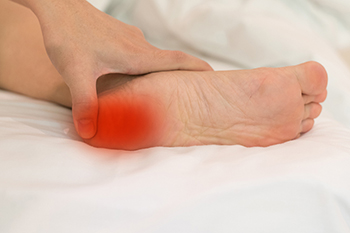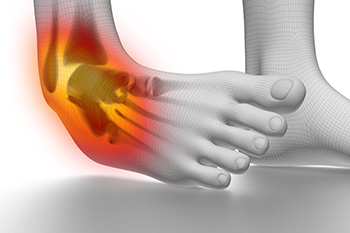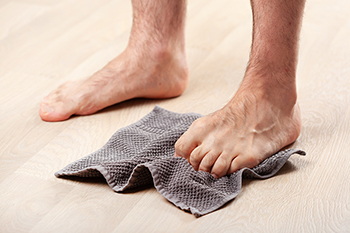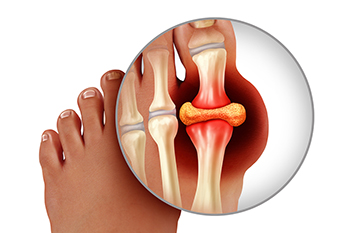Items filtered by date: May 2022
Causes of Pain in the Back or Bottom of the Heel

Pain can occur in different areas of the heel including the bottom or the back of the heel. Where heel pain is felt may help determine the cause of the pain. For instance, pain on the bottom of the heel may be due to a stress fracture in the heel bone or inflamed plantar fascia tissue on the sole of the foot. Plantar fasciitis is the most common cause of heel pain. Pain in the back of the heel may occur when shoes rub that area repeatedly and form a bony enlargement known as Haglund’s deformity. Heel pain also occurs when the fluid-filled bursa sac behind the ankle becomes inflamed and irritated. Further, heel pain in the back of the foot may be caused by a swollen Achilles tendon or by an irritated growth plate in the heel of a growing child is known as Sever’s disease. No matter what the cause of your heel pain may be, a chiropodist can diagnose it and come up with an effective plan to treat it.
Heel pain is a common problem that can be caused by a variety of injuries, medical conditions, and other factors. If you suffer from heel pain, please consult with Chiropodist Stephanie Poupore from North Bay Foot & Ankle. Our clinician can help you maintain the health of your lower limbs and your mobility.
When it comes to heel pain, the exact location and type of pain are important to note. Some of the conditions that may cause heel pain include:
-
Plantar fasciitis - An inflammation of the ligament that runs along the bottom of the foot; it causes a stabbing pain under the heel that is at its worst when taking your first few steps after a long rest and while standing on your tiptoes or climbing stairs
-
Achilles tendonitis - An inflammation of the tendon in the back of the calf; it causes pain in the back of the heel that is at its worst after resting, as well as ankle and calf stiffness, swelling, and tenderness
-
Bone spurs - Bony lumps on the back of the heel bones that cause sharp pain upon first standing up; the pain becomes dull and achy over time
-
Heel fractures - A break or crack in the heel bone that causes pain, swelling, and difficulty walking
-
Retrocalcaneal bursitis - Swelling of the small, fluid-filled sac at the back of the heel bone; it causes pain, swelling, redness, and warmth in the back of the heel
-
Tarsal tunnel syndrome - Compression of the posterior tibial nerve which causes a pins and needles sensation in the heel, foot, and calf
Your chiropodist will be able to diagnose the underlying cause of your pain and prescribe the right treatments for you. If you have any questions, please feel free to contact our office located in . We offer the newest diagnostic and treatment technologies for all your foot care needs.
Treating a Sprained Ankle

Ankle sprains are very common among anyone who is active in sports, making up about one-fourth of sports-related injuries. However, sprains can also occur accidentally by twisting your ankle while walking or missing your footing when going off of a step or curb. When the ligaments that support the ankle get overly stretched, it results in a sprain. Symptoms include pain, swelling, bruising, and difficulty bearing weight. Ankle sprains generally heal within six weeks but can take longer depending on the severity. Treatment includes rest to allow the ankle to heal. Taping, wearing a brace or splint, or wrapping it with an elastic bandage can help to stabilize the joint and reduce the chances of reinjury. Icing the ankle until the swelling goes down may also help. Most of all, be patient. Ankle sprains that do not heal properly can leave you open to further and sometimes more serious injuries. For more information on how to deal with an ankle sprain, please consult a chiropodist.
When one or more ligaments in the ankle overstretch or tear due to injury, an ankle sprain occurs. If you would like to learn more about ankle sprains, please consult with Chiropodist Stephanie Poupore from North Bay Foot & Ankle. Our clinician can help you maintain the health of your lower limbs and your mobility.
Symptoms of an ankle sprain vary depending on the severity of the injury, but may include:
-
Pain
-
Swelling
-
Bruising
-
Tenderness
-
Difficulty walking
-
Ankle instability
-
A reduced range of motion in the ankle
Treatments for an ankle sprain may consist of:
-
Resting the injured ankle
-
Applying ice
-
Elevating the ankle
-
Compressing the ankle
-
Over-the-counter pain medications
-
Ankle braces or other devices to take weight off of the ankle
-
Ankle exercises
-
Surgery (in rare cases)
It’s important for the sprained ankle to heal correctly and fully in order to avoid repeated injury. If you have any questions, please feel free to contact our office located in . We offer the newest diagnostic and treatment technologies for all your foot care needs.
Are You Suffering From Ingrown Toenails?
Sports and Sever’s Disease

Sever’s disease, also known as calcaneal apophysitis, is a condition that impacts heels on the feet of young people. It is often a result of inflammation to the growth plate in the heel arising from natural and sometimes uneven growth spurts in bones during puberty. The muscles and tendons, especially the Achilles tendon, can become tight and pull on the heel bone causing pain and swelling. It generally develops between the ages of eight and thirteen in girls and ten to fifteen in boys and is often transitory as the growth plate usually matures and hardens by age fifteen. This condition can occur in any child but those with flat feet, high arches, short leg syndrome, or childhood obesity are more at risk. A child in the affected age group who plays sports, like soccer, and runs or jumps a lot can complain about heel pain and this can be the culprit. Rest, ice, compression, and elevation (RICE), as well as stretching the Achilles tendon and calf will help with pain. See a chiropodist if your child develops heel or foot pain to properly diagnose the problem and create a treatment plan to best deal with symptoms and help your child return to normal functioning.
Sever’s disease typically affects young children and teenagers. If your child complains of foot pain, please consult with Chiropodist Stephanie Poupore from North Bay Foot & Ankle. Our clinician will assess your condition and provide you with quality foot and ankle treatment.
What Is Sever’s Disease?
Sever’s disease, also known as calcaneal apophysitis, is an inflammation of the growth plate in the heel bone. It is typically caused by overuse due to repetitive activities such as running, jumping, and playing certain sports. This condition most frequently affects children between the ages of 8 and 14.
Symptoms
Symptoms of Sever’s disease include:
-
Pain in the back or bottom of the heel
-
Pain when the sides of the heel are squeezed
-
Limping or walking on tiptoes to avoid putting pressure on the heel
-
Difficulty running, jumping, or participating in usual activities
-
Fatigue
Diagnosis
Sever’s disease is diagnosed by taking a thorough medical history and performing a physical examination. Imaging studies, such as an X-ray, can help rule out other injuries like a fracture.
Treatment
Sever’s disease typically heals without any long-term complications. Treatment involves resting the affected foot by reducing typical activities, wearing orthotics to support the foot, immobilizing the affected foot, taking medications to reduce pain and inflammation, and stretching the foot.
If you have any questions, please feel free to contact our office located in . We offer the newest diagnostic and treatment technologies for all your foot care needs.
How Can I Help My Foot Cramps?

Foot cramps can be a common problem. They may happen as a result of wearing shoes that are too tight while doing cardiovascular exercise. Research has shown that foot cramps may be diminished when frequent foot exercises are performed. Effective foot stretches can include placing your toes on the edge of a towel while sitting down, and pulling the towel under the toes by flexing the foot. Additionally, many people perform what is known as the marble/pencil grab. This is done by picking up marbles or pencils with your foot, while either in a sitting or standing position. A stretch that can strengthen the bottom of the foot is done by standing on a step while lowering one heel at a time until a gentle stretch is felt. If you are experiencing foot cramps, and would like more information on how to strengthen the feet, please confer with a chiropodist.
Stretching and strengthening your feet is very important for maintaining your foot health. If you would like to learn more about exercises for your feet, please consult with Chiropodist Stephanie Poupore from North Bay Foot & Ankle. Our clinician can help you maintain the health of your lower limbs and your mobility.
There are a variety of relatively easy-to-do exercises that can boost the strength, flexibility, and mobility of your feet, as well as relieve foot pain.
Strength exercises:
-
Toe splay - Spread the toes apart and hold for several seconds; improves control over toe muscles
-
Toe curls - Scrunch up a towel with your toes; strengthens the flexor muscles
-
Marble pickup - Pick up marbles with your toes; strengthens the muscles on the undersides of the feet and toes
-
Walking on sand - Stretches and strengthens feet and calves
Flexibility exercises:
-
Heel raises - Raise the heels while keeping toes on the ground
-
Toe point - Raise the heels while pointing the toes, keeping just the tips of toes on the ground
-
Toe curl - Raise the heels while curling the toes inwards, keeping just the tips of toes on the ground
-
Big toe stretch - Use your hands to gently stretch your big toes up, down, and to the side
Exercises for foot pain:
-
Toe extension - Gently pull the toes up towards the ankle and hold for several seconds
-
Ball roll - gently roll a golf or tennis ball underneath the arches of the feet
If you have any questions, please feel free to contact our office located in . We offer the newest diagnostic and treatment technologies for all your foot care needs.
Gout Causes and Treatments

Gout is a form of inflammatory arthritis that targets your joints, and commonly affects the big toe. The most common symptoms of gout are burning, itching or tingling in the joint, followed by painful swelling and redness. Men are more apt to experience gout, but women are more at risk after menopause. Being overweight and eating foods that are high in purines are major contributors to this painful condition. Purines are more abundant in seafood, red meat (especially organ meat), fried and processed foods, and sugar. A byproduct of purines is uric acid, which sometimes forms into crystals that stay in the joints and cause pain. Gout can flare up and recede, so constant awareness of diet and weight is essential in reducing flare ups. It is wise to drink plenty of water, eat more fruits (especially those high in vitamin C) vegetables, and low-fat dairy products, as these foods are lower in purines. If you think you may be having a gout attack, it is suggested that you seek the help of a chiropodist at your earliest opportunity.
Gout is a painful form of arthritis that can affect anyone. Please consult with Chiropodist Stephanie Poupore from North Bay Foot & Ankle. Our clinician will assess your condition and provide you with quality foot and ankle treatment.
What Is Gout?
Gout is characterized by sudden, severe attacks of pain, redness, and tenderness in the joints. This type of arthritis is caused by a buildup of uric acid in the bloodstream. When uric acid crystallizes in a joint, often the joint of the big toe, it can bring about a gout attack.
Symptoms
Symptoms of gout include:
-
Sudden and severe pain
-
Swelling
-
Redness
-
Warmth
-
Joint stiffness
-
Joint deformity
Diagnosis
A chiropodist will ask questions about your personal and family medical history, followed by an examination of the affected joint. Laboratory tests and x-rays are sometimes ordered to determine if the inflammation is caused by something other than gout. A sample of fluid taken from your joint can show whether it contains uric acid.
Treatment
Prescription medications or injections are used to treat the pain, swelling, and inflammation. Patients with chronic gout can also use behavioral modifications such as diet, exercise, and decreased intake of alcohol to help minimize the frequency of gout attacks. Foods and beverages that are high in purines should be avoided since purines are converted in the body to uric acid. If left untreated, this painful condition can leave your joint permanently damaged and swollen.
If you have any questions, please feel free to contact our office located in . We offer the newest diagnostic and treatment technologies for all your foot care needs.

